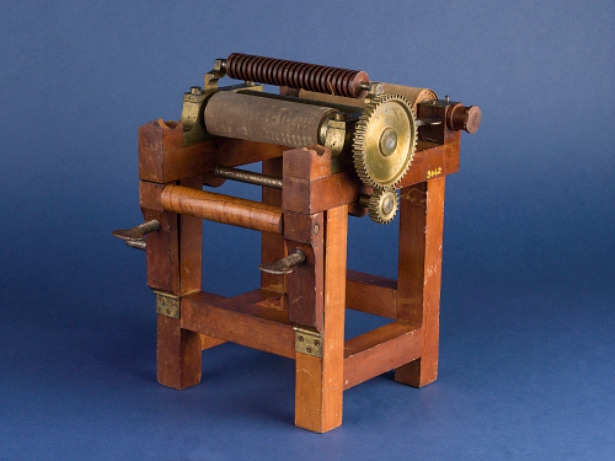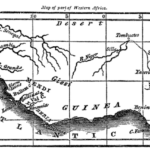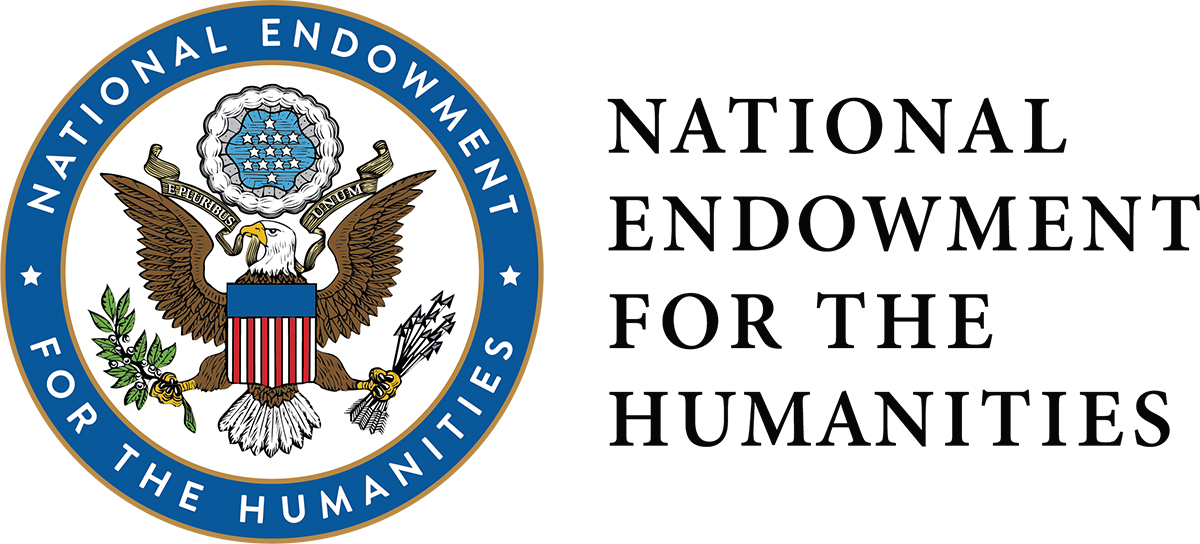Expansion and Reform (1801–1861)
The early 19th century witnessed America struggling to forge a post-revolutionary identity. Having come off success in its battle for independence, the explosive growth of cotton and slavery in the South facilitated divisive debates about the rights of all men to be free. These debates affected Connecticut slaveholders and abolitionists alike, manifesting themselves in such stories as those of Prudence Crandall and John Brown. Meanwhile, Connecticut slowly established itself as one of America’s most prominent manufacturing states, providing the country with iron, brass, rubber, textiles, clocks, gunpowder, and armaments. Facilitating the growth of these industries was a renewed focus on transportation infrastructure that brought about the construction of new roads and ambitious projects such as the Farmington and Windsor Locks canals.
Featured
James Benajmin Covey, a former slave, was only 14 years old when asked to serve in one of the most publicized trials in American history. …[more]
Learn More
58529
Q7VCV2X4
1
apsa
50
default
45709
https://connecticuthistory.org/wp-content/plugins/zotpress/
%7B%22status%22%3A%22success%22%2C%22updateneeded%22%3Afalse%2C%22instance%22%3Afalse%2C%22meta%22%3A%7B%22request_last%22%3A0%2C%22request_next%22%3A0%2C%22used_cache%22%3Atrue%7D%2C%22data%22%3A%5B%7B%22key%22%3A%229ESRZU9H%22%2C%22library%22%3A%7B%22id%22%3A58529%7D%2C%22meta%22%3A%7B%22lastModifiedByUser%22%3A%7B%22id%22%3A14399323%2C%22username%22%3A%22kquotap%22%2C%22name%22%3A%22%22%2C%22links%22%3A%7B%22alternate%22%3A%7B%22href%22%3A%22https%3A%5C%2F%5C%2Fwww.zotero.org%5C%2Fkquotap%22%2C%22type%22%3A%22text%5C%2Fhtml%22%7D%7D%7D%2C%22numChildren%22%3A0%7D%2C%22bib%22%3A%22%3Cdiv%20class%3D%5C%22csl-bib-body%5C%22%20style%3D%5C%22line-height%3A%201.35%3B%20padding-left%3A%201em%3B%20text-indent%3A-1em%3B%5C%22%3E%5Cn%20%20%3Cdiv%20class%3D%5C%22csl-entry%5C%22%3E%26%23x201C%3BThe%20Black%20Law%20of%20Connecticut%20%281833%29%20-%20Citizens%20ALL%3A%20African%20Americans%20in%20Connecticut%201700-1850.%26%23x201D%3B%20%3Ci%3EYale%20University%2C%20The%20Gilder%20Lehrman%20Center%20for%20the%20Study%20of%20Slavery%2C%20Resistance%2C%20%26amp%3B%20Abolition%3C%5C%2Fi%3E.%20%3Ca%20class%3D%27zp-ItemURL%27%20href%3D%27http%3A%5C%2F%5C%2Fglc.yale.edu%5C%2Fsites%5C%2Fdefault%5C%2Ffiles%5C%2Ffiles%5C%2FThe%2520Black%2520Law%2520of%2520Connecticut%25281%2529.pdf%27%3Ehttp%3A%5C%2F%5C%2Fglc.yale.edu%5C%2Fsites%5C%2Fdefault%5C%2Ffiles%5C%2Ffiles%5C%2FThe%2520Black%2520Law%2520of%2520Connecticut%25281%2529.pdf%3C%5C%2Fa%3E.%3C%5C%2Fdiv%3E%5Cn%3C%5C%2Fdiv%3E%22%2C%22data%22%3A%7B%22itemType%22%3A%22webpage%22%2C%22title%22%3A%22The%20Black%20Law%20of%20Connecticut%20%281833%29%20-%20Citizens%20ALL%3A%20African%20Americans%20in%20Connecticut%201700-1850%22%2C%22creators%22%3A%5B%5D%2C%22abstractNote%22%3A%22%22%2C%22date%22%3A%22%22%2C%22url%22%3A%22http%3A%5C%2F%5C%2Fglc.yale.edu%5C%2Fsites%5C%2Fdefault%5C%2Ffiles%5C%2Ffiles%5C%2FThe%2520Black%2520Law%2520of%2520Connecticut%25281%2529.pdf%22%2C%22language%22%3A%22%22%2C%22collections%22%3A%5B%22XSRXJV4B%22%2C%228W9INS82%22%2C%22EPTJI5QG%22%2C%22CRVJJDDQ%22%2C%224S9KGIDM%22%2C%22MPFZABFE%22%2C%22RNQEKFZ5%22%2C%2297PJ2GQS%22%2C%22TMXM39G6%22%2C%22DTI2HE3J%22%2C%22Q7VCV2X4%22%2C%222IBIPPQ4%22%5D%2C%22dateModified%22%3A%222024-07-10T14%3A39%3A59Z%22%7D%7D%2C%7B%22key%22%3A%227DETTGTS%22%2C%22library%22%3A%7B%22id%22%3A58529%7D%2C%22meta%22%3A%7B%22lastModifiedByUser%22%3A%7B%22id%22%3A14399323%2C%22username%22%3A%22kquotap%22%2C%22name%22%3A%22%22%2C%22links%22%3A%7B%22alternate%22%3A%7B%22href%22%3A%22https%3A%5C%2F%5C%2Fwww.zotero.org%5C%2Fkquotap%22%2C%22type%22%3A%22text%5C%2Fhtml%22%7D%7D%7D%2C%22creatorSummary%22%3A%22Judson%22%2C%22parsedDate%22%3A%221833%22%2C%22numChildren%22%3A0%7D%2C%22bib%22%3A%22%3Cdiv%20class%3D%5C%22csl-bib-body%5C%22%20style%3D%5C%22line-height%3A%201.35%3B%20padding-left%3A%201em%3B%20text-indent%3A-1em%3B%5C%22%3E%5Cn%20%20%3Cdiv%20class%3D%5C%22csl-entry%5C%22%3EJudson%2C%20Andrew.%201833.%20%26%23x201C%3BBroadside%3A%20Barbarism%3A%20Who%20Are%20Now%20the%20Savages%3F%20The%20Indians%2C%20the%20Georgians%2C%20or%20the%20Persecutors%20of%20the%20Noble%20Mind-Ed%20Miss%20Prudence%20Crandall%2C%20of%20Canterbury%2C%20and%20Her%20Excellent%20Pupil%20Miss%20Eliza%20Ann%20Hammond%20of%20Providence%3F%20Will%20Andrew%20T.%20Judson%2C%20for%20Himself%20and%20His%20Canter.%26%23x201D%3B%20%3Ca%20class%3D%27zp-ItemURL%27%20href%3D%27http%3A%5C%2F%5C%2Fhdl.handle.net%5C%2F11134%5C%2F40002%3A20075%27%3Ehttp%3A%5C%2F%5C%2Fhdl.handle.net%5C%2F11134%5C%2F40002%3A20075%3C%5C%2Fa%3E.%3C%5C%2Fdiv%3E%5Cn%3C%5C%2Fdiv%3E%22%2C%22data%22%3A%7B%22itemType%22%3A%22document%22%2C%22title%22%3A%22Broadside%3A%20Barbarism%3A%20Who%20Are%20Now%20the%20Savages%3F%20The%20Indians%2C%20the%20Georgians%2C%20or%20the%20persecutors%20of%20the%20noble%20mind-ed%20Miss%20Prudence%20Crandall%2C%20of%20Canterbury%2C%20and%20her%20excellent%20pupil%20Miss%20Eliza%20Ann%20Hammond%20of%20Providence%3F%20will%20Andrew%20T.%20Judson%2C%20for%20himself%20and%20his%20Canter%22%2C%22creators%22%3A%5B%7B%22creatorType%22%3A%22author%22%2C%22firstName%22%3A%22Andrew%22%2C%22lastName%22%3A%22Judson%22%7D%5D%2C%22abstractNote%22%3A%22Broadside%22%2C%22date%22%3A%221833%22%2C%22language%22%3A%22%22%2C%22url%22%3A%22http%3A%5C%2F%5C%2Fhdl.handle.net%5C%2F11134%5C%2F40002%3A20075%22%2C%22collections%22%3A%5B%22XSRXJV4B%22%2C%228W9INS82%22%2C%22MMT6VCJ4%22%2C%22I3MQ4VRV%22%2C%22TP85WHNN%22%2C%22Q7VCV2X4%22%2C%222IBIPPQ4%22%5D%2C%22dateModified%22%3A%222024-07-10T14%3A39%3A33Z%22%7D%7D%2C%7B%22key%22%3A%225CX6HWKS%22%2C%22library%22%3A%7B%22id%22%3A58529%7D%2C%22meta%22%3A%7B%22lastModifiedByUser%22%3A%7B%22id%22%3A14399323%2C%22username%22%3A%22kquotap%22%2C%22name%22%3A%22%22%2C%22links%22%3A%7B%22alternate%22%3A%7B%22href%22%3A%22https%3A%5C%2F%5C%2Fwww.zotero.org%5C%2Fkquotap%22%2C%22type%22%3A%22text%5C%2Fhtml%22%7D%7D%7D%2C%22numChildren%22%3A1%7D%2C%22bib%22%3A%22%3Cdiv%20class%3D%5C%22csl-bib-body%5C%22%20style%3D%5C%22line-height%3A%201.35%3B%20padding-left%3A%201em%3B%20text-indent%3A-1em%3B%5C%22%3E%5Cn%20%20%3Cdiv%20class%3D%5C%22csl-entry%5C%22%3E%26%23x201C%3BConnecticut%20Museum%20of%20Culture%20and%20History.%26%23x201D%3B%20%3Ca%20class%3D%27zp-ItemURL%27%20href%3D%27https%3A%5C%2F%5C%2Fwww.connecticutmuseum.org%5C%2F%27%3Ehttps%3A%5C%2F%5C%2Fwww.connecticutmuseum.org%5C%2F%3C%5C%2Fa%3E%20%28May%2013%2C%202012%29.%3C%5C%2Fdiv%3E%5Cn%3C%5C%2Fdiv%3E%22%2C%22data%22%3A%7B%22itemType%22%3A%22webpage%22%2C%22title%22%3A%22Connecticut%20Museum%20of%20Culture%20and%20History%22%2C%22creators%22%3A%5B%5D%2C%22abstractNote%22%3A%22%22%2C%22date%22%3A%22%22%2C%22url%22%3A%22https%3A%5C%2F%5C%2Fwww.connecticutmuseum.org%5C%2F%22%2C%22language%22%3A%22%22%2C%22collections%22%3A%5B%227ANKVEHM%22%2C%22ZID7ZZJF%22%2C%22IDIGH2FG%22%2C%22BZKV945T%22%2C%22X3R7GNIK%22%2C%224VRPXHHR%22%2C%22MPM982G4%22%2C%22Q7VCV2X4%22%2C%22TVAQX9N6%22%5D%2C%22dateModified%22%3A%222024-06-25T17%3A36%3A10Z%22%7D%7D%2C%7B%22key%22%3A%22TFWQRDBB%22%2C%22library%22%3A%7B%22id%22%3A58529%7D%2C%22meta%22%3A%7B%22lastModifiedByUser%22%3A%7B%22id%22%3A14399323%2C%22username%22%3A%22kquotap%22%2C%22name%22%3A%22%22%2C%22links%22%3A%7B%22alternate%22%3A%7B%22href%22%3A%22https%3A%5C%2F%5C%2Fwww.zotero.org%5C%2Fkquotap%22%2C%22type%22%3A%22text%5C%2Fhtml%22%7D%7D%7D%2C%22parsedDate%22%3A%222016%22%2C%22numChildren%22%3A1%7D%2C%22bib%22%3A%22%3Cdiv%20class%3D%5C%22csl-bib-body%5C%22%20style%3D%5C%22line-height%3A%201.35%3B%20padding-left%3A%201em%3B%20text-indent%3A-1em%3B%5C%22%3E%5Cn%20%20%3Cdiv%20class%3D%5C%22csl-entry%5C%22%3E%26%23x201C%3BUnderground%20Railroad%20Trail%20Map.%26%23x201D%3B%202016.%20%3Ci%3EConnecticut%20Freedom%20Trail%3C%5C%2Fi%3E.%20%3Ca%20class%3D%27zp-ItemURL%27%20href%3D%27https%3A%5C%2F%5C%2Ffreedomtrail.wpenginepowered.com%5C%2Fdirectory-category%5C%2Funderground-railroad%5C%2F%27%3Ehttps%3A%5C%2F%5C%2Ffreedomtrail.wpenginepowered.com%5C%2Fdirectory-category%5C%2Funderground-railroad%5C%2F%3C%5C%2Fa%3E.%3C%5C%2Fdiv%3E%5Cn%3C%5C%2Fdiv%3E%22%2C%22data%22%3A%7B%22itemType%22%3A%22webpage%22%2C%22title%22%3A%22Underground%20Railroad%20Trail%20Map%22%2C%22creators%22%3A%5B%5D%2C%22abstractNote%22%3A%22%22%2C%22date%22%3A%222016%22%2C%22url%22%3A%22https%3A%5C%2F%5C%2Ffreedomtrail.wpenginepowered.com%5C%2Fdirectory-category%5C%2Funderground-railroad%5C%2F%22%2C%22language%22%3A%22%22%2C%22collections%22%3A%5B%22ATCZZQAX%22%2C%22MPFZABFE%22%2C%22TNDVM7NZ%22%2C%22V325NQCJ%22%2C%22Z7Z5H79C%22%2C%22VX5VIHB6%22%2C%22Q7VCV2X4%22%2C%22C3HDBURW%22%5D%2C%22dateModified%22%3A%222024-01-30T15%3A33%3A07Z%22%7D%7D%2C%7B%22key%22%3A%22J5IDWDGU%22%2C%22library%22%3A%7B%22id%22%3A58529%7D%2C%22meta%22%3A%7B%22lastModifiedByUser%22%3A%7B%22id%22%3A14399323%2C%22username%22%3A%22kquotap%22%2C%22name%22%3A%22%22%2C%22links%22%3A%7B%22alternate%22%3A%7B%22href%22%3A%22https%3A%5C%2F%5C%2Fwww.zotero.org%5C%2Fkquotap%22%2C%22type%22%3A%22text%5C%2Fhtml%22%7D%7D%7D%2C%22parsedDate%22%3A%222016%22%2C%22numChildren%22%3A0%7D%2C%22bib%22%3A%22%3Cdiv%20class%3D%5C%22csl-bib-body%5C%22%20style%3D%5C%22line-height%3A%201.35%3B%20padding-left%3A%201em%3B%20text-indent%3A-1em%3B%5C%22%3E%5Cn%20%20%3Cdiv%20class%3D%5C%22csl-entry%5C%22%3E%26%23x201C%3BNew%20London%20County%20Court%20African%20Americans%20and%20People%20of%20Color%20Collection%20-%20Inventory%20of%20Records.%26%23x201D%3B%202016.%20%3Ci%3EConnecticut%20State%20Library%3C%5C%2Fi%3E.%20%3Ca%20class%3D%27zp-ItemURL%27%20href%3D%27https%3A%5C%2F%5C%2Fcslarchives.ctstatelibrary.org%5C%2Frepositories%5C%2F2%5C%2Fresources%5C%2F68%27%3Ehttps%3A%5C%2F%5C%2Fcslarchives.ctstatelibrary.org%5C%2Frepositories%5C%2F2%5C%2Fresources%5C%2F68%3C%5C%2Fa%3E.%3C%5C%2Fdiv%3E%5Cn%3C%5C%2Fdiv%3E%22%2C%22data%22%3A%7B%22itemType%22%3A%22webpage%22%2C%22title%22%3A%22New%20London%20County%20Court%20African%20Americans%20and%20People%20of%20Color%20Collection%20-%20Inventory%20of%20Records%22%2C%22creators%22%3A%5B%5D%2C%22abstractNote%22%3A%22%22%2C%22date%22%3A%222016%22%2C%22url%22%3A%22https%3A%5C%2F%5C%2Fcslarchives.ctstatelibrary.org%5C%2Frepositories%5C%2F2%5C%2Fresources%5C%2F68%22%2C%22language%22%3A%22%22%2C%22collections%22%3A%5B%22Q7VCV2X4%22%2C%222IBIPPQ4%22%5D%2C%22dateModified%22%3A%222023-09-12T15%3A15%3A00Z%22%7D%7D%2C%7B%22key%22%3A%22RNX6A9SZ%22%2C%22library%22%3A%7B%22id%22%3A58529%7D%2C%22meta%22%3A%7B%22lastModifiedByUser%22%3A%7B%22id%22%3A14399323%2C%22username%22%3A%22kquotap%22%2C%22name%22%3A%22%22%2C%22links%22%3A%7B%22alternate%22%3A%7B%22href%22%3A%22https%3A%5C%2F%5C%2Fwww.zotero.org%5C%2Fkquotap%22%2C%22type%22%3A%22text%5C%2Fhtml%22%7D%7D%7D%2C%22parsedDate%22%3A%222016%22%2C%22numChildren%22%3A0%7D%2C%22bib%22%3A%22%3Cdiv%20class%3D%5C%22csl-bib-body%5C%22%20style%3D%5C%22line-height%3A%201.35%3B%20padding-left%3A%201em%3B%20text-indent%3A-1em%3B%5C%22%3E%5Cn%20%20%3Cdiv%20class%3D%5C%22csl-entry%5C%22%3E%26%23x201C%3BThe%20Farmington%20Canal%20Heritage%20Trail.%26%23x201D%3B%202016.%20%3Ci%3EFarmington%20Valley%20Trails%20Council%3C%5C%2Fi%3E.%20%3Ca%20class%3D%27zp-ItemURL%27%20href%3D%27https%3A%5C%2F%5C%2Ffchtrail.org%5C%2F%27%3Ehttps%3A%5C%2F%5C%2Ffchtrail.org%5C%2F%3C%5C%2Fa%3E.%3C%5C%2Fdiv%3E%5Cn%3C%5C%2Fdiv%3E%22%2C%22data%22%3A%7B%22itemType%22%3A%22webpage%22%2C%22title%22%3A%22The%20Farmington%20Canal%20Heritage%20Trail%22%2C%22creators%22%3A%5B%5D%2C%22abstractNote%22%3A%22%22%2C%22date%22%3A%222016%22%2C%22url%22%3A%22https%3A%5C%2F%5C%2Ffchtrail.org%5C%2F%22%2C%22language%22%3A%22%22%2C%22collections%22%3A%5B%22PPM3B6QC%22%2C%22JGTGRCMX%22%2C%229PBVTIK4%22%2C%229CQQHFM3%22%2C%226RC7KKMZ%22%2C%223I3Z6CAT%22%2C%22RRU4PPTD%22%2C%228HEXCEHX%22%2C%22V9TZ92PG%22%2C%22X5MC4J95%22%2C%22JSXT5TRJ%22%2C%22T6X4BSXC%22%2C%22TKRX4GTT%22%2C%22WS6WK92I%22%2C%22X2G2AEWH%22%2C%22RTMDNHR3%22%2C%22DCBTWVWU%22%2C%224N89FB2T%22%2C%22ZUGZH6TW%22%2C%22BRWB89X6%22%2C%22AM7JC4IN%22%2C%229Q8JB4F7%22%2C%22T7XHI3TI%22%2C%225882U9Z3%22%2C%22Q7VCV2X4%22%2C%22TVAQX9N6%22%2C%22ZBG88C7T%22%5D%2C%22dateModified%22%3A%222023-09-12T15%3A13%3A44Z%22%7D%7D%2C%7B%22key%22%3A%22ER3BR3FR%22%2C%22library%22%3A%7B%22id%22%3A58529%7D%2C%22meta%22%3A%7B%22lastModifiedByUser%22%3A%7B%22id%22%3A14399323%2C%22username%22%3A%22kquotap%22%2C%22name%22%3A%22%22%2C%22links%22%3A%7B%22alternate%22%3A%7B%22href%22%3A%22https%3A%5C%2F%5C%2Fwww.zotero.org%5C%2Fkquotap%22%2C%22type%22%3A%22text%5C%2Fhtml%22%7D%7D%7D%2C%22parsedDate%22%3A%222016%22%2C%22numChildren%22%3A1%7D%2C%22bib%22%3A%22%3Cdiv%20class%3D%5C%22csl-bib-body%5C%22%20style%3D%5C%22line-height%3A%201.35%3B%20padding-left%3A%201em%3B%20text-indent%3A-1em%3B%5C%22%3E%5Cn%20%20%3Cdiv%20class%3D%5C%22csl-entry%5C%22%3E%26%23x201C%3BJohn%20Brown%20Birthplace.%26%23x201D%3B%202016.%20%3Ci%3ETorrington%20Historical%20Society%3C%5C%2Fi%3E.%20%3Ca%20class%3D%27zp-ItemURL%27%20href%3D%27https%3A%5C%2F%5C%2Ftorringtonhistoricalsociety.org%5C%2Fjohn-browns-birthplace-site%5C%2F%23%3A~%3Atext%3DThe%2520birthplace%2520site%2520is%2520listed%2Cparents%252C%2520Owen%2520and%2520Ruth%2520Brown.%27%3Ehttps%3A%5C%2F%5C%2Ftorringtonhistoricalsociety.org%5C%2Fjohn-browns-birthplace-site%5C%2F%23%3A~%3Atext%3DThe%2520birthplace%2520site%2520is%2520listed%2Cparents%252C%2520Owen%2520and%2520Ruth%2520Brown.%3C%5C%2Fa%3E%3C%5C%2Fdiv%3E%5Cn%3C%5C%2Fdiv%3E%22%2C%22data%22%3A%7B%22itemType%22%3A%22webpage%22%2C%22title%22%3A%22John%20Brown%20Birthplace%22%2C%22creators%22%3A%5B%5D%2C%22abstractNote%22%3A%22%22%2C%22date%22%3A%222016%22%2C%22url%22%3A%22https%3A%5C%2F%5C%2Ftorringtonhistoricalsociety.org%5C%2Fjohn-browns-birthplace-site%5C%2F%23%3A~%3Atext%3DThe%2520birthplace%2520site%2520is%2520listed%2Cparents%252C%2520Owen%2520and%2520Ruth%2520Brown.%22%2C%22language%22%3A%22%22%2C%22collections%22%3A%5B%22TEZVRVZU%22%2C%22XNVPNJ9Q%22%2C%22ZMVBDER3%22%2C%226TD9UWA8%22%2C%22CWZREBF3%22%2C%22T7XHI3TI%22%2C%22BG4RZD2W%22%2C%227D3TARZH%22%2C%22UN3MEPAX%22%2C%22Q7VCV2X4%22%2C%22TVAQX9N6%22%5D%2C%22dateModified%22%3A%222023-09-12T15%3A13%3A21Z%22%7D%7D%2C%7B%22key%22%3A%22PMB8AKJT%22%2C%22library%22%3A%7B%22id%22%3A58529%7D%2C%22meta%22%3A%7B%22lastModifiedByUser%22%3A%7B%22id%22%3A14399323%2C%22username%22%3A%22kquotap%22%2C%22name%22%3A%22%22%2C%22links%22%3A%7B%22alternate%22%3A%7B%22href%22%3A%22https%3A%5C%2F%5C%2Fwww.zotero.org%5C%2Fkquotap%22%2C%22type%22%3A%22text%5C%2Fhtml%22%7D%7D%7D%2C%22numChildren%22%3A1%7D%2C%22bib%22%3A%22%3Cdiv%20class%3D%5C%22csl-bib-body%5C%22%20style%3D%5C%22line-height%3A%201.35%3B%20padding-left%3A%201em%3B%20text-indent%3A-1em%3B%5C%22%3E%5Cn%20%20%3Cdiv%20class%3D%5C%22csl-entry%5C%22%3E%26%23x201C%3BNewspapers%20of%20Connecticut%3A%20Charter%20Oak%20%28ca.%201838-1843%29%20-%20Digital%20Newspaper%20Archive.%26%23x201D%3B%20%3Ci%3EConnecticut%20State%20Library%3C%5C%2Fi%3E.%20%3Ca%20class%3D%27zp-ItemURL%27%20href%3D%27https%3A%5C%2F%5C%2Fcollections.ctdigitalarchive.org%5C%2Fislandora%5C%2Fobject%5C%2F30002%253Ao5910546%27%3Ehttps%3A%5C%2F%5C%2Fcollections.ctdigitalarchive.org%5C%2Fislandora%5C%2Fobject%5C%2F30002%253Ao5910546%3C%5C%2Fa%3E.%3C%5C%2Fdiv%3E%5Cn%3C%5C%2Fdiv%3E%22%2C%22data%22%3A%7B%22itemType%22%3A%22webpage%22%2C%22title%22%3A%22Newspapers%20of%20Connecticut%3A%20Charter%20Oak%20%28ca.%201838-1843%29%20-%20digital%20newspaper%20archive%22%2C%22creators%22%3A%5B%5D%2C%22abstractNote%22%3A%22%22%2C%22date%22%3A%22%22%2C%22url%22%3A%22https%3A%5C%2F%5C%2Fcollections.ctdigitalarchive.org%5C%2Fislandora%5C%2Fobject%5C%2F30002%253Ao5910546%22%2C%22language%22%3A%22%22%2C%22collections%22%3A%5B%22WBQ6D4KD%22%2C%2295E33QX9%22%2C%22TPHBE8PV%22%2C%2294M2P9J7%22%2C%22MPFZABFE%22%2C%22VPSI5N5U%22%2C%22DH9RNBVB%22%2C%22WS9PSHAI%22%2C%22F2CA5XAD%22%2C%22Q7VCV2X4%22%2C%222IBIPPQ4%22%5D%2C%22dateModified%22%3A%222022-01-31T17%3A39%3A32Z%22%7D%7D%2C%7B%22key%22%3A%223FNBDEAJ%22%2C%22library%22%3A%7B%22id%22%3A58529%7D%2C%22meta%22%3A%7B%22lastModifiedByUser%22%3A%7B%22id%22%3A14399323%2C%22username%22%3A%22kquotap%22%2C%22name%22%3A%22%22%2C%22links%22%3A%7B%22alternate%22%3A%7B%22href%22%3A%22https%3A%5C%2F%5C%2Fwww.zotero.org%5C%2Fkquotap%22%2C%22type%22%3A%22text%5C%2Fhtml%22%7D%7D%7D%2C%22parsedDate%22%3A%222016%22%2C%22numChildren%22%3A1%7D%2C%22bib%22%3A%22%3Cdiv%20class%3D%5C%22csl-bib-body%5C%22%20style%3D%5C%22line-height%3A%201.35%3B%20padding-left%3A%201em%3B%20text-indent%3A-1em%3B%5C%22%3E%5Cn%20%20%3Cdiv%20class%3D%5C%22csl-entry%5C%22%3E%26%23x201C%3BFarmington%20Historical%20Society.%26%23x201D%3B%202016.%20%3Ca%20class%3D%27zp-ItemURL%27%20href%3D%27https%3A%5C%2F%5C%2Ffhs-ct.org%5C%2F%27%3Ehttps%3A%5C%2F%5C%2Ffhs-ct.org%5C%2F%3C%5C%2Fa%3E.%3C%5C%2Fdiv%3E%5Cn%3C%5C%2Fdiv%3E%22%2C%22data%22%3A%7B%22itemType%22%3A%22webpage%22%2C%22title%22%3A%22Farmington%20Historical%20Society%22%2C%22creators%22%3A%5B%5D%2C%22abstractNote%22%3A%22%22%2C%22date%22%3A%222016%22%2C%22url%22%3A%22https%3A%5C%2F%5C%2Ffhs-ct.org%5C%2F%22%2C%22language%22%3A%22%22%2C%22collections%22%3A%5B%22V9TZ92PG%22%2C%22TKRX4GTT%22%2C%22664W473J%22%2C%22DIP52CFP%22%2C%224P9CDX9W%22%2C%22H5UQ5MAB%22%2C%22Q7VCV2X4%22%2C%22TVAQX9N6%22%5D%2C%22dateModified%22%3A%222020-08-24T11%3A11%3A54Z%22%7D%7D%2C%7B%22key%22%3A%22ZT8FN3I6%22%2C%22library%22%3A%7B%22id%22%3A58529%7D%2C%22meta%22%3A%7B%22lastModifiedByUser%22%3A%7B%22id%22%3A14399323%2C%22username%22%3A%22kquotap%22%2C%22name%22%3A%22%22%2C%22links%22%3A%7B%22alternate%22%3A%7B%22href%22%3A%22https%3A%5C%2F%5C%2Fwww.zotero.org%5C%2Fkquotap%22%2C%22type%22%3A%22text%5C%2Fhtml%22%7D%7D%7D%2C%22parsedDate%22%3A%222017%22%2C%22numChildren%22%3A0%7D%2C%22bib%22%3A%22%3Cdiv%20class%3D%5C%22csl-bib-body%5C%22%20style%3D%5C%22line-height%3A%201.35%3B%20padding-left%3A%201em%3B%20text-indent%3A-1em%3B%5C%22%3E%5Cn%20%20%3Cdiv%20class%3D%5C%22csl-entry%5C%22%3E%26%23x201C%3BHarriet%20Beecher%20Stowe%20Center.%26%23x201D%3B%202017.%20%3Ca%20class%3D%27zp-ItemURL%27%20href%3D%27https%3A%5C%2F%5C%2Fwww.harrietbeecherstowecenter.org%5C%2F%27%3Ehttps%3A%5C%2F%5C%2Fwww.harrietbeecherstowecenter.org%5C%2F%3C%5C%2Fa%3E.%3C%5C%2Fdiv%3E%5Cn%3C%5C%2Fdiv%3E%22%2C%22data%22%3A%7B%22itemType%22%3A%22webpage%22%2C%22title%22%3A%22Harriet%20Beecher%20Stowe%20Center%22%2C%22creators%22%3A%5B%5D%2C%22abstractNote%22%3A%22%22%2C%22date%22%3A%222017%22%2C%22url%22%3A%22https%3A%5C%2F%5C%2Fwww.harrietbeecherstowecenter.org%5C%2F%22%2C%22language%22%3A%22%22%2C%22collections%22%3A%5B%22BTH8RJJV%22%2C%22CXNTVQTT%22%2C%22BMQDD9DN%22%2C%22TWXEXRE3%22%2C%22PI58JD9H%22%2C%22P5NQG6BG%22%2C%227SXUTXQT%22%2C%22C7HQG4ZW%22%2C%2223DR9C2V%22%2C%22C8N45EN5%22%2C%22M8XV7UMN%22%2C%2266WDPUSS%22%2C%22Q7635EXA%22%2C%22K7A64GED%22%2C%22FFR9TSCZ%22%2C%225F5984C9%22%2C%22S2HPVKQX%22%2C%22IH3PJBMG%22%2C%22XX44Q4IC%22%2C%225882U9Z3%22%2C%22DTH3PX3E%22%2C%22EU9CITUC%22%2C%22P78663H2%22%2C%22TFZ4I7XN%22%2C%227ZWWR62Q%22%2C%22SVXXC336%22%2C%229SBVBHIJ%22%2C%22Q7VCV2X4%22%2C%22TVAQX9N6%22%5D%2C%22dateModified%22%3A%222020-03-05T17%3A10%3A19Z%22%7D%7D%2C%7B%22key%22%3A%223FDDCI9T%22%2C%22library%22%3A%7B%22id%22%3A58529%7D%2C%22meta%22%3A%7B%22lastModifiedByUser%22%3A%7B%22id%22%3A14399323%2C%22username%22%3A%22kquotap%22%2C%22name%22%3A%22%22%2C%22links%22%3A%7B%22alternate%22%3A%7B%22href%22%3A%22https%3A%5C%2F%5C%2Fwww.zotero.org%5C%2Fkquotap%22%2C%22type%22%3A%22text%5C%2Fhtml%22%7D%7D%7D%2C%22parsedDate%22%3A%222017%22%2C%22numChildren%22%3A0%7D%2C%22bib%22%3A%22%3Cdiv%20class%3D%5C%22csl-bib-body%5C%22%20style%3D%5C%22line-height%3A%201.35%3B%20padding-left%3A%201em%3B%20text-indent%3A-1em%3B%5C%22%3E%5Cn%20%20%3Cdiv%20class%3D%5C%22csl-entry%5C%22%3E%26%23x201C%3BConnecticut%26%23x2019%3Bs%20Old%20State%20House.%26%23x201D%3B%202017.%20%3Ca%20class%3D%27zp-ItemURL%27%20href%3D%27https%3A%5C%2F%5C%2Fwww.cga.ct.gov%5C%2Fosh%5C%2F%27%3Ehttps%3A%5C%2F%5C%2Fwww.cga.ct.gov%5C%2Fosh%5C%2F%3C%5C%2Fa%3E.%3C%5C%2Fdiv%3E%5Cn%3C%5C%2Fdiv%3E%22%2C%22data%22%3A%7B%22itemType%22%3A%22webpage%22%2C%22title%22%3A%22Connecticut%27s%20Old%20State%20House%22%2C%22creators%22%3A%5B%5D%2C%22abstractNote%22%3A%22%22%2C%22date%22%3A%222017%22%2C%22url%22%3A%22https%3A%5C%2F%5C%2Fwww.cga.ct.gov%5C%2Fosh%5C%2F%22%2C%22language%22%3A%22%22%2C%22collections%22%3A%5B%2275J4TSPR%22%2C%22ACPVWXXQ%22%2C%22CTGEE4UN%22%2C%22V8MMFGKJ%22%2C%224TT9AFCI%22%2C%22V9BPJJUS%22%2C%22VSXQTTTM%22%2C%22M883D3IK%22%2C%226GD28MDM%22%2C%2266WDPUSS%22%2C%22Q7635EXA%22%2C%22X8ITPJ85%22%2C%22RH5SWVPT%22%2C%22DHWXMN77%22%2C%225F5984C9%22%2C%22S2HPVKQX%22%2C%223GEWCIMH%22%2C%225882U9Z3%22%2C%22BG4RZD2W%22%2C%227D3TARZH%22%2C%224P9CDX9W%22%2C%22H5UQ5MAB%22%2C%22AZIV27BU%22%2C%22C2XTNRE6%22%2C%22DI77DVM8%22%2C%22W5RT8QM2%22%2C%22QCMVN9CA%22%2C%22Q7VCV2X4%22%2C%22TVAQX9N6%22%2C%22CA7EXVR2%22%2C%22V9596JQ3%22%5D%2C%22dateModified%22%3A%222020-02-24T21%3A10%3A51Z%22%7D%7D%2C%7B%22key%22%3A%22FUUMIEE5%22%2C%22library%22%3A%7B%22id%22%3A58529%7D%2C%22meta%22%3A%7B%22lastModifiedByUser%22%3A%7B%22id%22%3A14399323%2C%22username%22%3A%22kquotap%22%2C%22name%22%3A%22%22%2C%22links%22%3A%7B%22alternate%22%3A%7B%22href%22%3A%22https%3A%5C%2F%5C%2Fwww.zotero.org%5C%2Fkquotap%22%2C%22type%22%3A%22text%5C%2Fhtml%22%7D%7D%7D%2C%22creatorSummary%22%3A%22Morse%22%2C%22parsedDate%22%3A%221933%22%2C%22numChildren%22%3A0%7D%2C%22bib%22%3A%22%3Cdiv%20class%3D%5C%22csl-bib-body%5C%22%20style%3D%5C%22line-height%3A%201.35%3B%20padding-left%3A%201em%3B%20text-indent%3A-1em%3B%5C%22%3E%5Cn%20%20%3Cdiv%20class%3D%5C%22csl-entry%5C%22%3EMorse%2C%20Jarvis%20Means.%201933.%20%3Ci%3EA%20Neglected%20Period%20of%20Connecticut%26%23x2019%3Bs%20History%2C%201818-1850%3C%5C%2Fi%3E.%20New%20Haven%3B%20London%3A%20Yale%20University%20Press%3B%20H.%20Milford%2C%20Oxford%20University%20Press.%3C%5C%2Fdiv%3E%5Cn%3C%5C%2Fdiv%3E%22%2C%22data%22%3A%7B%22itemType%22%3A%22book%22%2C%22title%22%3A%22A%20Neglected%20Period%20of%20Connecticut%27s%20History%2C%201818-1850%22%2C%22creators%22%3A%5B%7B%22creatorType%22%3A%22author%22%2C%22firstName%22%3A%22Jarvis%20Means%22%2C%22lastName%22%3A%22Morse%22%7D%5D%2C%22abstractNote%22%3A%22%22%2C%22date%22%3A%221933%22%2C%22language%22%3A%22English%22%2C%22ISBN%22%3A%22%22%2C%22url%22%3A%22%22%2C%22collections%22%3A%5B%22Q7VCV2X4%22%2C%2266WXF5VQ%22%5D%2C%22dateModified%22%3A%222017-01-03T21%3A52%3A51Z%22%7D%7D%2C%7B%22key%22%3A%22HGJWR778%22%2C%22library%22%3A%7B%22id%22%3A58529%7D%2C%22meta%22%3A%7B%22lastModifiedByUser%22%3A%7B%22id%22%3A14399323%2C%22username%22%3A%22kquotap%22%2C%22name%22%3A%22%22%2C%22links%22%3A%7B%22alternate%22%3A%7B%22href%22%3A%22https%3A%5C%2F%5C%2Fwww.zotero.org%5C%2Fkquotap%22%2C%22type%22%3A%22text%5C%2Fhtml%22%7D%7D%7D%2C%22parsedDate%22%3A%222016%22%2C%22numChildren%22%3A0%7D%2C%22bib%22%3A%22%3Cdiv%20class%3D%5C%22csl-bib-body%5C%22%20style%3D%5C%22line-height%3A%201.35%3B%20padding-left%3A%201em%3B%20text-indent%3A-1em%3B%5C%22%3E%5Cn%20%20%3Cdiv%20class%3D%5C%22csl-entry%5C%22%3E%26%23x201C%3BNaugatuck%20Historical%20Society.%26%23x201D%3B%202016.%20%3Ca%20class%3D%27zp-ItemURL%27%20href%3D%27http%3A%5C%2F%5C%2Fwww.naugatuckhistory.org%5C%2F%27%3Ehttp%3A%5C%2F%5C%2Fwww.naugatuckhistory.org%5C%2F%3C%5C%2Fa%3E.%3C%5C%2Fdiv%3E%5Cn%3C%5C%2Fdiv%3E%22%2C%22data%22%3A%7B%22itemType%22%3A%22webpage%22%2C%22title%22%3A%22Naugatuck%20Historical%20Society%22%2C%22creators%22%3A%5B%5D%2C%22abstractNote%22%3A%22%22%2C%22date%22%3A%222016%22%2C%22url%22%3A%22http%3A%5C%2F%5C%2Fwww.naugatuckhistory.org%5C%2F%22%2C%22language%22%3A%22%22%2C%22collections%22%3A%5B%22WWW5I8TM%22%2C%228VBSQPGU%22%2C%22TZW6UZ2N%22%2C%22QDKCN28X%22%2C%22Z8D4XGZ3%22%2C%22W7AC2VBX%22%2C%22D3IUN8R3%22%2C%22N8Q4XPVJ%22%2C%22XQEEQWIN%22%2C%227R382USG%22%2C%22CAGHE6WD%22%2C%22PIRVUTX6%22%2C%22Q7VCV2X4%22%2C%22TVAQX9N6%22%2C%22M966GTHT%22%2C%22GNJHXQ4N%22%5D%2C%22dateModified%22%3A%222017-01-02T19%3A14%3A37Z%22%7D%7D%2C%7B%22key%22%3A%2253SJD4TA%22%2C%22library%22%3A%7B%22id%22%3A58529%7D%2C%22meta%22%3A%7B%22lastModifiedByUser%22%3A%7B%22id%22%3A14399323%2C%22username%22%3A%22kquotap%22%2C%22name%22%3A%22%22%2C%22links%22%3A%7B%22alternate%22%3A%7B%22href%22%3A%22https%3A%5C%2F%5C%2Fwww.zotero.org%5C%2Fkquotap%22%2C%22type%22%3A%22text%5C%2Fhtml%22%7D%7D%7D%2C%22parsedDate%22%3A%222016%22%2C%22numChildren%22%3A0%7D%2C%22bib%22%3A%22%3Cdiv%20class%3D%5C%22csl-bib-body%5C%22%20style%3D%5C%22line-height%3A%201.35%3B%20padding-left%3A%201em%3B%20text-indent%3A-1em%3B%5C%22%3E%5Cn%20%20%3Cdiv%20class%3D%5C%22csl-entry%5C%22%3E%26%23x201C%3BWilliam%20Lanson%20Site.%26%23x201D%3B%202016.%20%3Ci%3EConnecticut%20Freedom%20Trail%3C%5C%2Fi%3E.%20%3Ca%20class%3D%27zp-ItemURL%27%20href%3D%27http%3A%5C%2F%5C%2Fwww.ctfreedomtrail.org%5C%2Ftrail%5C%2Fconcept-of-freedom%5C%2Fsites%5C%2F%23%21%5C%2Fwilliam-lanson-site%27%3Ehttp%3A%5C%2F%5C%2Fwww.ctfreedomtrail.org%5C%2Ftrail%5C%2Fconcept-of-freedom%5C%2Fsites%5C%2F%23%21%5C%2Fwilliam-lanson-site%3C%5C%2Fa%3E.%3C%5C%2Fdiv%3E%5Cn%3C%5C%2Fdiv%3E%22%2C%22data%22%3A%7B%22itemType%22%3A%22webpage%22%2C%22title%22%3A%22William%20Lanson%20Site%22%2C%22creators%22%3A%5B%5D%2C%22abstractNote%22%3A%22%22%2C%22date%22%3A%222016%22%2C%22url%22%3A%22http%3A%5C%2F%5C%2Fwww.ctfreedomtrail.org%5C%2Ftrail%5C%2Fconcept-of-freedom%5C%2Fsites%5C%2F%23%21%5C%2Fwilliam-lanson-site%22%2C%22language%22%3A%22%22%2C%22collections%22%3A%5B%224VT55EZW%22%2C%226U3CHWZ2%22%2C%22Q7VCV2X4%22%2C%22TVAQX9N6%22%5D%2C%22dateModified%22%3A%222016-12-07T20%3A42%3A34Z%22%7D%7D%2C%7B%22key%22%3A%22QT64KEWQ%22%2C%22library%22%3A%7B%22id%22%3A58529%7D%2C%22meta%22%3A%7B%22lastModifiedByUser%22%3A%7B%22id%22%3A14399323%2C%22username%22%3A%22kquotap%22%2C%22name%22%3A%22%22%2C%22links%22%3A%7B%22alternate%22%3A%7B%22href%22%3A%22https%3A%5C%2F%5C%2Fwww.zotero.org%5C%2Fkquotap%22%2C%22type%22%3A%22text%5C%2Fhtml%22%7D%7D%7D%2C%22parsedDate%22%3A%222016%22%2C%22numChildren%22%3A1%7D%2C%22bib%22%3A%22%3Cdiv%20class%3D%5C%22csl-bib-body%5C%22%20style%3D%5C%22line-height%3A%201.35%3B%20padding-left%3A%201em%3B%20text-indent%3A-1em%3B%5C%22%3E%5Cn%20%20%3Cdiv%20class%3D%5C%22csl-entry%5C%22%3E%26%23x201C%3BJohn%20Brown%26%23x2019%3Bs%20Sharps%20Rifle.%26%23x201D%3B%202016.%20%3Ci%3ENational%20Museum%20of%20American%20History%3C%5C%2Fi%3E.%20%3Ca%20class%3D%27zp-ItemURL%27%20href%3D%27http%3A%5C%2F%5C%2Famericanhistory.si.edu%5C%2Fcollections%5C%2Fsearch%5C%2Fobject%5C%2Fnmah_440084%27%3Ehttp%3A%5C%2F%5C%2Famericanhistory.si.edu%5C%2Fcollections%5C%2Fsearch%5C%2Fobject%5C%2Fnmah_440084%3C%5C%2Fa%3E.%3C%5C%2Fdiv%3E%5Cn%3C%5C%2Fdiv%3E%22%2C%22data%22%3A%7B%22itemType%22%3A%22webpage%22%2C%22title%22%3A%22John%20Brown%27s%20Sharps%20Rifle%22%2C%22creators%22%3A%5B%5D%2C%22abstractNote%22%3A%22%22%2C%22date%22%3A%222016%22%2C%22url%22%3A%22http%3A%5C%2F%5C%2Famericanhistory.si.edu%5C%2Fcollections%5C%2Fsearch%5C%2Fobject%5C%2Fnmah_440084%22%2C%22language%22%3A%22%22%2C%22collections%22%3A%5B%22TEZVRVZU%22%2C%22BNZCUKN5%22%2C%22QGWM79M3%22%2C%22W3JKMWVQ%22%2C%22Q7VCV2X4%22%2C%222IBIPPQ4%22%5D%2C%22dateModified%22%3A%222016-12-02T17%3A28%3A15Z%22%7D%7D%2C%7B%22key%22%3A%22U7TWNWHB%22%2C%22library%22%3A%7B%22id%22%3A58529%7D%2C%22meta%22%3A%7B%22lastModifiedByUser%22%3A%7B%22id%22%3A14399323%2C%22username%22%3A%22kquotap%22%2C%22name%22%3A%22%22%2C%22links%22%3A%7B%22alternate%22%3A%7B%22href%22%3A%22https%3A%5C%2F%5C%2Fwww.zotero.org%5C%2Fkquotap%22%2C%22type%22%3A%22text%5C%2Fhtml%22%7D%7D%7D%2C%22parsedDate%22%3A%222016%22%2C%22numChildren%22%3A1%7D%2C%22bib%22%3A%22%3Cdiv%20class%3D%5C%22csl-bib-body%5C%22%20style%3D%5C%22line-height%3A%201.35%3B%20padding-left%3A%201em%3B%20text-indent%3A-1em%3B%5C%22%3E%5Cn%20%20%3Cdiv%20class%3D%5C%22csl-entry%5C%22%3E%26%23x201C%3BThe%20Amistad%20Center%20for%20Art%20%26amp%3B%20Culture.%26%23x201D%3B%202016.%20%3Ci%3EWadsworth%20Atheneum%20Museum%20of%20Art%3C%5C%2Fi%3E.%20%3Ca%20class%3D%27zp-ItemURL%27%20href%3D%27http%3A%5C%2F%5C%2Fwww.amistadcenter.org%5C%2F%27%3Ehttp%3A%5C%2F%5C%2Fwww.amistadcenter.org%5C%2F%3C%5C%2Fa%3E.%3C%5C%2Fdiv%3E%5Cn%3C%5C%2Fdiv%3E%22%2C%22data%22%3A%7B%22itemType%22%3A%22webpage%22%2C%22title%22%3A%22The%20Amistad%20Center%20for%20Art%20%26%20Culture%22%2C%22creators%22%3A%5B%5D%2C%22abstractNote%22%3A%22%22%2C%22date%22%3A%222016%22%2C%22url%22%3A%22http%3A%5C%2F%5C%2Fwww.amistadcenter.org%5C%2F%22%2C%22language%22%3A%22%22%2C%22collections%22%3A%5B%22WBQ6D4KD%22%2C%22TEZVRVZU%22%2C%22MPFZABFE%22%2C%22TNDVM7NZ%22%2C%2266WDPUSS%22%2C%22Q7635EXA%22%2C%22CWZREBF3%22%2C%2293EZECPS%22%2C%224P9CDX9W%22%2C%22H5UQ5MAB%22%2C%22UN3MEPAX%22%2C%22W5RT8QM2%22%2C%22QCMVN9CA%22%2C%2244U6T43P%22%2C%22Q7VCV2X4%22%2C%22TVAQX9N6%22%5D%2C%22dateModified%22%3A%222016-09-26T16%3A12%3A43Z%22%7D%7D%2C%7B%22key%22%3A%22U8Q6C4MX%22%2C%22library%22%3A%7B%22id%22%3A58529%7D%2C%22meta%22%3A%7B%22lastModifiedByUser%22%3A%7B%22id%22%3A14399323%2C%22username%22%3A%22kquotap%22%2C%22name%22%3A%22%22%2C%22links%22%3A%7B%22alternate%22%3A%7B%22href%22%3A%22https%3A%5C%2F%5C%2Fwww.zotero.org%5C%2Fkquotap%22%2C%22type%22%3A%22text%5C%2Fhtml%22%7D%7D%7D%2C%22parsedDate%22%3A%222016%22%2C%22numChildren%22%3A0%7D%2C%22bib%22%3A%22%3Cdiv%20class%3D%5C%22csl-bib-body%5C%22%20style%3D%5C%22line-height%3A%201.35%3B%20padding-left%3A%201em%3B%20text-indent%3A-1em%3B%5C%22%3E%5Cn%20%20%3Cdiv%20class%3D%5C%22csl-entry%5C%22%3E%26%23x201C%3BPrudence%20Crandall%20House.%26%23x201D%3B%202016.%20%3Ci%3EConnecticut%20Freedom%20Trail%3C%5C%2Fi%3E.%20%3Ca%20class%3D%27zp-ItemURL%27%20href%3D%27http%3A%5C%2F%5C%2Fwww.ctfreedomtrail.org%5C%2Ftrail%5C%2Fconcept-of-freedom%5C%2Fsites%5C%2F%23%21%5C%2Fprudence-crandall%27%3Ehttp%3A%5C%2F%5C%2Fwww.ctfreedomtrail.org%5C%2Ftrail%5C%2Fconcept-of-freedom%5C%2Fsites%5C%2F%23%21%5C%2Fprudence-crandall%3C%5C%2Fa%3E%20%28July%2023%2C%202012%29.%3C%5C%2Fdiv%3E%5Cn%3C%5C%2Fdiv%3E%22%2C%22data%22%3A%7B%22itemType%22%3A%22webpage%22%2C%22title%22%3A%22Prudence%20Crandall%20House%22%2C%22creators%22%3A%5B%5D%2C%22abstractNote%22%3A%22%22%2C%22date%22%3A%222016%22%2C%22url%22%3A%22http%3A%5C%2F%5C%2Fwww.ctfreedomtrail.org%5C%2Ftrail%5C%2Fconcept-of-freedom%5C%2Fsites%5C%2F%23%21%5C%2Fprudence-crandall%22%2C%22language%22%3A%22%22%2C%22collections%22%3A%5B%22XSRXJV4B%22%2C%228J747TRG%22%2C%22C8N45EN5%22%2C%22Q7VCV2X4%22%2C%22TVAQX9N6%22%5D%2C%22dateModified%22%3A%222016-09-07T21%3A07%3A15Z%22%7D%7D%2C%7B%22key%22%3A%22R33W85FB%22%2C%22library%22%3A%7B%22id%22%3A58529%7D%2C%22meta%22%3A%7B%22lastModifiedByUser%22%3A%7B%22id%22%3A14399323%2C%22username%22%3A%22kquotap%22%2C%22name%22%3A%22%22%2C%22links%22%3A%7B%22alternate%22%3A%7B%22href%22%3A%22https%3A%5C%2F%5C%2Fwww.zotero.org%5C%2Fkquotap%22%2C%22type%22%3A%22text%5C%2Fhtml%22%7D%7D%7D%2C%22creatorSummary%22%3A%22Lawrance%22%2C%22parsedDate%22%3A%222014%22%2C%22numChildren%22%3A0%7D%2C%22bib%22%3A%22%3Cdiv%20class%3D%5C%22csl-bib-body%5C%22%20style%3D%5C%22line-height%3A%201.35%3B%20padding-left%3A%201em%3B%20text-indent%3A-1em%3B%5C%22%3E%5Cn%20%20%3Cdiv%20class%3D%5C%22csl-entry%5C%22%3ELawrance%2C%20Benjamin%20Nicholas.%202014.%20%3Ci%3EAmistad%26%23x2019%3Bs%20Orphans%3A%20An%20Atlantic%20Story%20of%20Children%2C%20Slavery%2C%20and%20Smuggling%3C%5C%2Fi%3E.%20New%20Haven%2C%20CT%3A%20Yale%20University%20Press.%3C%5C%2Fdiv%3E%5Cn%3C%5C%2Fdiv%3E%22%2C%22data%22%3A%7B%22itemType%22%3A%22book%22%2C%22title%22%3A%22Amistad%27s%20Orphans%3A%20An%20Atlantic%20Story%20of%20Children%2C%20Slavery%2C%20and%20Smuggling%22%2C%22creators%22%3A%5B%7B%22creatorType%22%3A%22author%22%2C%22firstName%22%3A%22Benjamin%20Nicholas%22%2C%22lastName%22%3A%22Lawrance%22%7D%5D%2C%22abstractNote%22%3A%22%22%2C%22date%22%3A%222014%22%2C%22language%22%3A%22English%22%2C%22ISBN%22%3A%22978-0-300-19845-4%22%2C%22url%22%3A%22%22%2C%22collections%22%3A%5B%224P9CDX9W%22%2C%22NSPS5KWJ%22%2C%22WEAGPWR2%22%2C%22W5RT8QM2%22%2C%22Q7VCV2X4%22%2C%2266WXF5VQ%22%5D%2C%22dateModified%22%3A%222015-12-11T14%3A56%3A33Z%22%7D%7D%2C%7B%22key%22%3A%22R973JG7Q%22%2C%22library%22%3A%7B%22id%22%3A58529%7D%2C%22meta%22%3A%7B%22lastModifiedByUser%22%3A%7B%22id%22%3A14399323%2C%22username%22%3A%22kquotap%22%2C%22name%22%3A%22%22%2C%22links%22%3A%7B%22alternate%22%3A%7B%22href%22%3A%22https%3A%5C%2F%5C%2Fwww.zotero.org%5C%2Fkquotap%22%2C%22type%22%3A%22text%5C%2Fhtml%22%7D%7D%7D%2C%22creatorSummary%22%3A%22Barber%22%2C%22parsedDate%22%3A%221840%22%2C%22numChildren%22%3A1%7D%2C%22bib%22%3A%22%3Cdiv%20class%3D%5C%22csl-bib-body%5C%22%20style%3D%5C%22line-height%3A%201.35%3B%20padding-left%3A%201em%3B%20text-indent%3A-1em%3B%5C%22%3E%5Cn%20%20%3Cdiv%20class%3D%5C%22csl-entry%5C%22%3EBarber%2C%20John%20Warner.%201840.%20%3Ci%3EA%20History%20of%20the%20Amistad%20Captives%3A%20Being%20a%20Circumstantial%20Account%20of%20the%20Capture%20of%20the%20Spanish%20Schooner%20Amistad%2C%20by%20the%20Africans%20on%20Board%3A%20Their%20Voyage%2C%20and%20Capture%20Near%20Long%20Island%2C%20New%20York%3A%20With%20Biographical%20Sketches%20of%20Each%20of%20the%20Surviving%20Africans%3B%20Also%2C%20an%20Account%20of%20the%20Trials%20Had%20on%20Their%20Case%2C%20Before%20the%20District%20and%20Circuit%20Courts%20of%20the%20United%20States%2C%20for%20the%20District%20of%20Connecticut%3C%5C%2Fi%3E.%20John%20W.%20Barber.%20%3Ca%20class%3D%27zp-ItemURL%27%20href%3D%27https%3A%5C%2F%5C%2Farchive.org%5C%2Fstream%5C%2FASPC0001874900%23page%5C%2Fn1%5C%2Fmode%5C%2F2up%27%3Ehttps%3A%5C%2F%5C%2Farchive.org%5C%2Fstream%5C%2FASPC0001874900%23page%5C%2Fn1%5C%2Fmode%5C%2F2up%3C%5C%2Fa%3E%20%28December%2011%2C%202015%29.%3C%5C%2Fdiv%3E%5Cn%3C%5C%2Fdiv%3E%22%2C%22data%22%3A%7B%22itemType%22%3A%22book%22%2C%22title%22%3A%22A%20History%20of%20the%20Amistad%20Captives%3A%20Being%20a%20Circumstantial%20Account%20of%20the%20Capture%20of%20the%20Spanish%20Schooner%20Amistad%2C%20by%20the%20Africans%20on%20Board%3A%20Their%20Voyage%2C%20and%20Capture%20Near%20Long%20Island%2C%20New%20York%3A%20With%20Biographical%20Sketches%20of%20Each%20of%20the%20Surviving%20Africans%3B%20Also%2C%20an%20Account%20of%20the%20Trials%20Had%20on%20Their%20Case%2C%20Before%20the%20District%20and%20Circuit%20Courts%20of%20the%20United%20States%2C%20for%20the%20District%20of%20Connecticut%22%2C%22creators%22%3A%5B%7B%22creatorType%22%3A%22author%22%2C%22firstName%22%3A%22John%20Warner%22%2C%22lastName%22%3A%22Barber%22%7D%5D%2C%22abstractNote%22%3A%22%22%2C%22date%22%3A%221840%22%2C%22language%22%3A%22eng%22%2C%22ISBN%22%3A%22%22%2C%22url%22%3A%22https%3A%5C%2F%5C%2Farchive.org%5C%2Fstream%5C%2FASPC0001874900%23page%5C%2Fn1%5C%2Fmode%5C%2F2up%22%2C%22collections%22%3A%5B%224P9CDX9W%22%2C%22NSPS5KWJ%22%2C%22WEAGPWR2%22%2C%22W5RT8QM2%22%2C%22Q7VCV2X4%22%2C%2266WXF5VQ%22%5D%2C%22dateModified%22%3A%222015-12-11T14%3A54%3A07Z%22%7D%7D%2C%7B%22key%22%3A%22RNHXFBKC%22%2C%22library%22%3A%7B%22id%22%3A58529%7D%2C%22meta%22%3A%7B%22lastModifiedByUser%22%3A%7B%22id%22%3A14399323%2C%22username%22%3A%22kquotap%22%2C%22name%22%3A%22%22%2C%22links%22%3A%7B%22alternate%22%3A%7B%22href%22%3A%22https%3A%5C%2F%5C%2Fwww.zotero.org%5C%2Fkquotap%22%2C%22type%22%3A%22text%5C%2Fhtml%22%7D%7D%7D%2C%22creatorSummary%22%3A%22Colt%22%2C%22parsedDate%22%3A%221850%22%2C%22numChildren%22%3A1%7D%2C%22bib%22%3A%22%3Cdiv%20class%3D%5C%22csl-bib-body%5C%22%20style%3D%5C%22line-height%3A%201.35%3B%20padding-left%3A%201em%3B%20text-indent%3A-1em%3B%5C%22%3E%5Cn%20%20%3Cdiv%20class%3D%5C%22csl-entry%5C%22%3EColt%2C%20Samuel.%201850.%20%26%23x201C%3BBroadside%3A%20Colt%26%23x2019%3Bs%20Patent%20Repeating%20Pistols%2C%20Army%2C%20Navy%2C%20and%20Pocket%20Sizes.%26%23x201D%3B%20%3Ca%20class%3D%27zp-ItemURL%27%20href%3D%27http%3A%5C%2F%5C%2Fhdl.handle.net%5C%2F11134%5C%2F40002%3A20781%27%3Ehttp%3A%5C%2F%5C%2Fhdl.handle.net%5C%2F11134%5C%2F40002%3A20781%3C%5C%2Fa%3E.%3C%5C%2Fdiv%3E%5Cn%3C%5C%2Fdiv%3E%22%2C%22data%22%3A%7B%22itemType%22%3A%22document%22%2C%22title%22%3A%22Broadside%3A%20Colt%27s%20Patent%20Repeating%20Pistols%2C%20Army%2C%20Navy%2C%20and%20Pocket%20Sizes.%22%2C%22creators%22%3A%5B%7B%22creatorType%22%3A%22author%22%2C%22firstName%22%3A%22Samuel%22%2C%22lastName%22%3A%22Colt%22%7D%5D%2C%22abstractNote%22%3A%22%22%2C%22date%22%3A%221850%22%2C%22language%22%3A%22%22%2C%22url%22%3A%22http%3A%5C%2F%5C%2Fhdl.handle.net%5C%2F11134%5C%2F40002%3A20781%22%2C%22collections%22%3A%5B%22TDGXGPD7%22%2C%22HSIPMBXQ%22%2C%22G63IIPBI%22%2C%22JB7XKIUV%22%2C%22Q7VCV2X4%22%2C%222IBIPPQ4%22%5D%2C%22dateModified%22%3A%222015-12-10T19%3A52%3A52Z%22%7D%7D%2C%7B%22key%22%3A%22FZJSIBTM%22%2C%22library%22%3A%7B%22id%22%3A58529%7D%2C%22meta%22%3A%7B%22lastModifiedByUser%22%3A%7B%22id%22%3A14399323%2C%22username%22%3A%22kquotap%22%2C%22name%22%3A%22%22%2C%22links%22%3A%7B%22alternate%22%3A%7B%22href%22%3A%22https%3A%5C%2F%5C%2Fwww.zotero.org%5C%2Fkquotap%22%2C%22type%22%3A%22text%5C%2Fhtml%22%7D%7D%7D%2C%22creatorSummary%22%3A%22Goodyear%22%2C%22parsedDate%22%3A%221844-03-09%22%2C%22numChildren%22%3A1%7D%2C%22bib%22%3A%22%3Cdiv%20class%3D%5C%22csl-bib-body%5C%22%20style%3D%5C%22line-height%3A%201.35%3B%20padding-left%3A%201em%3B%20text-indent%3A-1em%3B%5C%22%3E%5Cn%20%20%3Cdiv%20class%3D%5C%22csl-entry%5C%22%3EGoodyear%2C%20Charles.%201844.%20%26%23x201C%3BPatent%20Number%203%2C462%20-%20Manufacture%20of%20India%20Rubber%20Goods.%26%23x201D%3B%20%3Ca%20class%3D%27zp-ItemURL%27%20href%3D%27https%3A%5C%2F%5C%2Fdocs.google.com%5C%2Fviewer%3Furl%3Dpatentimages.storage.googleapis.com%5C%2Fpdfs%5C%2FUS3462.pdf%27%3Ehttps%3A%5C%2F%5C%2Fdocs.google.com%5C%2Fviewer%3Furl%3Dpatentimages.storage.googleapis.com%5C%2Fpdfs%5C%2FUS3462.pdf%3C%5C%2Fa%3E%20%28September%2024%2C%202015%29.%3C%5C%2Fdiv%3E%5Cn%3C%5C%2Fdiv%3E%22%2C%22data%22%3A%7B%22itemType%22%3A%22patent%22%2C%22title%22%3A%22Patent%20Number%203%2C462%20-%20Manufacture%20of%20India%20Rubber%20Goods%22%2C%22creators%22%3A%5B%7B%22creatorType%22%3A%22inventor%22%2C%22firstName%22%3A%22Charles%22%2C%22lastName%22%3A%22Goodyear%22%7D%5D%2C%22abstractNote%22%3A%22%22%2C%22country%22%3A%22United%20States%22%2C%22assignee%22%3A%22%22%2C%22issuingAuthority%22%3A%22%22%2C%22patentNumber%22%3A%22US3462%20A%22%2C%22filingDate%22%3A%22%22%2C%22applicationNumber%22%3A%22%22%2C%22priorityNumbers%22%3A%22%22%2C%22issueDate%22%3A%22March%209%2C%201844%22%2C%22references%22%3A%22%22%2C%22legalStatus%22%3A%22%22%2C%22language%22%3A%22%22%2C%22url%22%3A%22https%3A%5C%2F%5C%2Fdocs.google.com%5C%2Fviewer%3Furl%3Dpatentimages.storage.googleapis.com%5C%2Fpdfs%5C%2FUS3462.pdf%22%2C%22collections%22%3A%5B%22WWW5I8TM%22%2C%22Z9PEGTIG%22%2C%22DDW3SQME%22%2C%22Q7VCV2X4%22%2C%222IBIPPQ4%22%5D%2C%22dateModified%22%3A%222015-09-24T14%3A03%3A04Z%22%7D%7D%2C%7B%22key%22%3A%22GWVVU9JD%22%2C%22library%22%3A%7B%22id%22%3A58529%7D%2C%22meta%22%3A%7B%22lastModifiedByUser%22%3A%7B%22id%22%3A14399323%2C%22username%22%3A%22kquotap%22%2C%22name%22%3A%22%22%2C%22links%22%3A%7B%22alternate%22%3A%7B%22href%22%3A%22https%3A%5C%2F%5C%2Fwww.zotero.org%5C%2Fkquotap%22%2C%22type%22%3A%22text%5C%2Fhtml%22%7D%7D%7D%2C%22creatorSummary%22%3A%22Menschel%22%2C%22parsedDate%22%3A%222001-09-24%22%2C%22numChildren%22%3A0%7D%2C%22bib%22%3A%22%3Cdiv%20class%3D%5C%22csl-bib-body%5C%22%20style%3D%5C%22line-height%3A%201.35%3B%20padding-left%3A%201em%3B%20text-indent%3A-1em%3B%5C%22%3E%5Cn%20%20%3Cdiv%20class%3D%5C%22csl-entry%5C%22%3EMenschel%2C%20David.%202001.%20%26%23x201C%3BAbolition%20Without%20Deliverance%3A%20The%20Law%20of%20Connecticut%20Slavery%201784-1848.%26%23x201D%3B%20%3Ci%3EYale%20Law%20Journal%3C%5C%2Fi%3E%20111%28183%29.%20%3Ca%20class%3D%27zp-ItemURL%27%20href%3D%27http%3A%5C%2F%5C%2Fwww.yalelawjournal.org%5C%2Fpdf%5C%2F452_udpoi658.pdf%27%3Ehttp%3A%5C%2F%5C%2Fwww.yalelawjournal.org%5C%2Fpdf%5C%2F452_udpoi658.pdf%3C%5C%2Fa%3E.%3C%5C%2Fdiv%3E%5Cn%3C%5C%2Fdiv%3E%22%2C%22data%22%3A%7B%22itemType%22%3A%22journalArticle%22%2C%22title%22%3A%22Abolition%20Without%20Deliverance%3A%20The%20Law%20of%20Connecticut%20Slavery%201784-1848%22%2C%22creators%22%3A%5B%7B%22creatorType%22%3A%22author%22%2C%22firstName%22%3A%22David%22%2C%22lastName%22%3A%22Menschel%22%7D%5D%2C%22abstractNote%22%3A%22%22%2C%22date%22%3A%22September%2024%2C%202001%22%2C%22language%22%3A%22%22%2C%22DOI%22%3A%22%22%2C%22ISSN%22%3A%22%22%2C%22url%22%3A%22http%3A%5C%2F%5C%2Fwww.yalelawjournal.org%5C%2Fpdf%5C%2F452_udpoi658.pdf%22%2C%22collections%22%3A%5B%22QNXMRCV6%22%2C%22Q7VCV2X4%22%2C%22M4XDR5W4%22%5D%2C%22dateModified%22%3A%222015-09-09T21%3A18%3A15Z%22%7D%7D%2C%7B%22key%22%3A%22EHCZGCE3%22%2C%22library%22%3A%7B%22id%22%3A58529%7D%2C%22meta%22%3A%7B%22lastModifiedByUser%22%3A%7B%22id%22%3A14399323%2C%22username%22%3A%22kquotap%22%2C%22name%22%3A%22%22%2C%22links%22%3A%7B%22alternate%22%3A%7B%22href%22%3A%22https%3A%5C%2F%5C%2Fwww.zotero.org%5C%2Fkquotap%22%2C%22type%22%3A%22text%5C%2Fhtml%22%7D%7D%7D%2C%22creatorSummary%22%3A%22Normen%22%2C%22parsedDate%22%3A%222013%22%2C%22numChildren%22%3A0%7D%2C%22bib%22%3A%22%3Cdiv%20class%3D%5C%22csl-bib-body%5C%22%20style%3D%5C%22line-height%3A%201.35%3B%20padding-left%3A%201em%3B%20text-indent%3A-1em%3B%5C%22%3E%5Cn%20%20%3Cdiv%20class%3D%5C%22csl-entry%5C%22%3ENormen%2C%20Elizabeth%20J.%2C%20ed.%202013.%20%3Ci%3EAfrican%20American%20Connecticut%20Explored%3C%5C%2Fi%3E.%20Middletown%2C%20CT%3A%20Wesleyan%20University%20Press.%3C%5C%2Fdiv%3E%5Cn%3C%5C%2Fdiv%3E%22%2C%22data%22%3A%7B%22itemType%22%3A%22book%22%2C%22title%22%3A%22African%20American%20Connecticut%20Explored%22%2C%22creators%22%3A%5B%7B%22creatorType%22%3A%22editor%22%2C%22firstName%22%3A%22Elizabeth%20J.%22%2C%22lastName%22%3A%22Normen%22%7D%5D%2C%22abstractNote%22%3A%22%22%2C%22date%22%3A%222013%22%2C%22language%22%3A%22English%22%2C%22ISBN%22%3A%22978-0-8195-7398-8%200-8195-7398-1%22%2C%22url%22%3A%22%22%2C%22collections%22%3A%5B%22WBQ6D4KD%22%2C%22SII5HEV5%22%2C%22SAGFDHM6%22%2C%22HM6F62HV%22%2C%22DN9SVMAA%22%2C%22KSWFDFTX%22%2C%22BP7UJBSU%22%2C%22Q7VCV2X4%22%2C%2266WXF5VQ%22%5D%2C%22dateModified%22%3A%222015-07-14T19%3A51%3A43Z%22%7D%7D%2C%7B%22key%22%3A%22TPA6DJ33%22%2C%22library%22%3A%7B%22id%22%3A58529%7D%2C%22meta%22%3A%7B%22lastModifiedByUser%22%3A%7B%22id%22%3A14399323%2C%22username%22%3A%22kquotap%22%2C%22name%22%3A%22%22%2C%22links%22%3A%7B%22alternate%22%3A%7B%22href%22%3A%22https%3A%5C%2F%5C%2Fwww.zotero.org%5C%2Fkquotap%22%2C%22type%22%3A%22text%5C%2Fhtml%22%7D%7D%7D%2C%22parsedDate%22%3A%221784%22%2C%22numChildren%22%3A1%7D%2C%22bib%22%3A%22%3Cdiv%20class%3D%5C%22csl-bib-body%5C%22%20style%3D%5C%22line-height%3A%201.35%3B%20padding-left%3A%201em%3B%20text-indent%3A-1em%3B%5C%22%3E%5Cn%20%20%3Cdiv%20class%3D%5C%22csl-entry%5C%22%3E%26%23x201C%3BActs%20and%20Laws%20of%20the%20State%20of%20Connecticut%2C%20in%20America%20-%20Slaves.%26%23x201D%3B%201784.%20%3Ca%20class%3D%27zp-ItemURL%27%20href%3D%27http%3A%5C%2F%5C%2Fbeinecke.library.yale.edu%5C%2Fdl_crosscollex%5C%2Fbrbldl_getrec.asp%3Ffld%3Dimg%26id%3D1091528%27%3Ehttp%3A%5C%2F%5C%2Fbeinecke.library.yale.edu%5C%2Fdl_crosscollex%5C%2Fbrbldl_getrec.asp%3Ffld%3Dimg%26id%3D1091528%3C%5C%2Fa%3E.%3C%5C%2Fdiv%3E%5Cn%3C%5C%2Fdiv%3E%22%2C%22data%22%3A%7B%22itemType%22%3A%22document%22%2C%22title%22%3A%22Acts%20and%20Laws%20of%20the%20State%20of%20Connecticut%2C%20in%20America%20-%20Slaves%22%2C%22creators%22%3A%5B%5D%2C%22abstractNote%22%3A%22%22%2C%22date%22%3A%221784%22%2C%22language%22%3A%22%22%2C%22url%22%3A%22http%3A%5C%2F%5C%2Fbeinecke.library.yale.edu%5C%2Fdl_crosscollex%5C%2Fbrbldl_getrec.asp%3Ffld%3Dimg%26id%3D1091528%22%2C%22collections%22%3A%5B%22WBQ6D4KD%22%2C%2295E33QX9%22%2C%22MPFZABFE%22%2C%22VPSI5N5U%22%2C%2297PJ2GQS%22%2C%225PJ8H6G5%22%2C%22CDBG3M5Q%22%2C%22Q7VCV2X4%22%2C%222IBIPPQ4%22%5D%2C%22dateModified%22%3A%222013-01-30T15%3A05%3A34Z%22%7D%7D%2C%7B%22key%22%3A%223CTE8PSF%22%2C%22library%22%3A%7B%22id%22%3A58529%7D%2C%22meta%22%3A%7B%22lastModifiedByUser%22%3A%7B%22id%22%3A14399323%2C%22username%22%3A%22kquotap%22%2C%22name%22%3A%22%22%2C%22links%22%3A%7B%22alternate%22%3A%7B%22href%22%3A%22https%3A%5C%2F%5C%2Fwww.zotero.org%5C%2Fkquotap%22%2C%22type%22%3A%22text%5C%2Fhtml%22%7D%7D%7D%2C%22creatorSummary%22%3A%22DeLuca%22%2C%22parsedDate%22%3A%222011%22%2C%22numChildren%22%3A0%7D%2C%22bib%22%3A%22%3Cdiv%20class%3D%5C%22csl-bib-body%5C%22%20style%3D%5C%22line-height%3A%201.35%3B%20padding-left%3A%201em%3B%20text-indent%3A-1em%3B%5C%22%3E%5Cn%20%20%3Cdiv%20class%3D%5C%22csl-entry%5C%22%3EDeLuca%2C%20Richard.%202011.%20%3Ci%3EPost%20Roads%20%26amp%3B%20Iron%20Horses%3A%20Transportation%20in%20Connecticut%20from%20Colonial%20Times%20to%20the%20Age%20of%20Steam%3C%5C%2Fi%3E.%20Middletown%2C%26%23xA0%3B%20CT%3A%20Wesleyan%20University%20Press.%3C%5C%2Fdiv%3E%5Cn%3C%5C%2Fdiv%3E%22%2C%22data%22%3A%7B%22itemType%22%3A%22book%22%2C%22title%22%3A%22Post%20Roads%20%26%20Iron%20Horses%3A%20Transportation%20in%20Connecticut%20from%20Colonial%20Times%20to%20the%20Age%20of%20Steam%22%2C%22creators%22%3A%5B%7B%22creatorType%22%3A%22author%22%2C%22firstName%22%3A%22Richard%22%2C%22lastName%22%3A%22DeLuca%22%7D%5D%2C%22abstractNote%22%3A%22%22%2C%22date%22%3A%222011%22%2C%22language%22%3A%22%22%2C%22ISBN%22%3A%229780819568564%22%2C%22url%22%3A%22%22%2C%22collections%22%3A%5B%22PRRQRESZ%22%2C%22SGCSAAE2%22%2C%22FBFE7JR3%22%2C%22S8HK3DAK%22%2C%22SXD2ERPB%22%2C%22PPM3B6QC%22%2C%22TXMW8PZA%22%2C%22Q7VCV2X4%22%2C%2266WXF5VQ%22%5D%2C%22dateModified%22%3A%222012-11-09T21%3A13%3A48Z%22%7D%7D%2C%7B%22key%22%3A%223HDQTPQ7%22%2C%22library%22%3A%7B%22id%22%3A58529%7D%2C%22meta%22%3A%7B%22lastModifiedByUser%22%3A%7B%22id%22%3A14399323%2C%22username%22%3A%22kquotap%22%2C%22name%22%3A%22%22%2C%22links%22%3A%7B%22alternate%22%3A%7B%22href%22%3A%22https%3A%5C%2F%5C%2Fwww.zotero.org%5C%2Fkquotap%22%2C%22type%22%3A%22text%5C%2Fhtml%22%7D%7D%7D%2C%22creatorSummary%22%3A%22MacMullen%22%2C%22parsedDate%22%3A%221991%22%2C%22numChildren%22%3A0%7D%2C%22bib%22%3A%22%3Cdiv%20class%3D%5C%22csl-bib-body%5C%22%20style%3D%5C%22line-height%3A%201.35%3B%20padding-left%3A%201em%3B%20text-indent%3A-1em%3B%5C%22%3E%5Cn%20%20%3Cdiv%20class%3D%5C%22csl-entry%5C%22%3EMacMullen%2C%20Edith%20Nye.%201991.%20%3Ci%3EIn%20the%20Cause%20of%20True%20Education%3A%20Henry%20Barnard%20%26amp%3B%20Nineteenth-Century%20School%20Reform%3C%5C%2Fi%3E.%20New%20Haven%2C%20CT%3A%20Yale%20University%20Press.%3C%5C%2Fdiv%3E%5Cn%3C%5C%2Fdiv%3E%22%2C%22data%22%3A%7B%22itemType%22%3A%22book%22%2C%22title%22%3A%22In%20the%20Cause%20of%20True%20Education%3A%20Henry%20Barnard%20%26%20Nineteenth-Century%20School%20Reform%22%2C%22creators%22%3A%5B%7B%22creatorType%22%3A%22author%22%2C%22firstName%22%3A%22Edith%20Nye%22%2C%22lastName%22%3A%22MacMullen%22%7D%5D%2C%22abstractNote%22%3A%22%22%2C%22date%22%3A%221991%22%2C%22language%22%3A%22English%22%2C%22ISBN%22%3A%220300048092%20%209780300048094%22%2C%22url%22%3A%22%22%2C%22collections%22%3A%5B%22WI7SVPAX%22%2C%22B8KMCPZN%22%2C%22APDW9JXN%22%2C%22Q7VCV2X4%22%2C%2266WXF5VQ%22%5D%2C%22dateModified%22%3A%222012-11-06T21%3A14%3A48Z%22%7D%7D%2C%7B%22key%22%3A%22NCFI2T2H%22%2C%22library%22%3A%7B%22id%22%3A58529%7D%2C%22meta%22%3A%7B%22lastModifiedByUser%22%3A%7B%22id%22%3A14399323%2C%22username%22%3A%22kquotap%22%2C%22name%22%3A%22%22%2C%22links%22%3A%7B%22alternate%22%3A%7B%22href%22%3A%22https%3A%5C%2F%5C%2Fwww.zotero.org%5C%2Fkquotap%22%2C%22type%22%3A%22text%5C%2Fhtml%22%7D%7D%7D%2C%22creatorSummary%22%3A%22Strother%22%2C%22parsedDate%22%3A%221962%22%2C%22numChildren%22%3A0%7D%2C%22bib%22%3A%22%3Cdiv%20class%3D%5C%22csl-bib-body%5C%22%20style%3D%5C%22line-height%3A%201.35%3B%20padding-left%3A%201em%3B%20text-indent%3A-1em%3B%5C%22%3E%5Cn%20%20%3Cdiv%20class%3D%5C%22csl-entry%5C%22%3EStrother%2C%20Horatio%20T.%201962.%20%3Ci%3EThe%20Underground%20Railroad%20in%20Connecticut%3C%5C%2Fi%3E.%20Middletown%2C%20CT%3A%20Wesleyan%20University%20Press.%20%3Ca%20class%3D%27zp-ItemURL%27%20href%3D%27http%3A%5C%2F%5C%2Farchive.org%5C%2Fstream%5C%2Fundergroundrailr1962stro%23page%5C%2Fn5%5C%2Fmode%5C%2F2up%27%3Ehttp%3A%5C%2F%5C%2Farchive.org%5C%2Fstream%5C%2Fundergroundrailr1962stro%23page%5C%2Fn5%5C%2Fmode%5C%2F2up%3C%5C%2Fa%3E.%3C%5C%2Fdiv%3E%5Cn%3C%5C%2Fdiv%3E%22%2C%22data%22%3A%7B%22itemType%22%3A%22book%22%2C%22title%22%3A%22The%20Underground%20Railroad%20in%20Connecticut%22%2C%22creators%22%3A%5B%7B%22creatorType%22%3A%22author%22%2C%22firstName%22%3A%22Horatio%20T.%22%2C%22lastName%22%3A%22Strother%22%7D%5D%2C%22abstractNote%22%3A%22%22%2C%22date%22%3A%221962%22%2C%22language%22%3A%22English%22%2C%22ISBN%22%3A%22%22%2C%22url%22%3A%22http%3A%5C%2F%5C%2Farchive.org%5C%2Fstream%5C%2Fundergroundrailr1962stro%23page%5C%2Fn5%5C%2Fmode%5C%2F2up%22%2C%22collections%22%3A%5B%22WBQ6D4KD%22%2C%22SII5HEV5%22%2C%22PSUSVQBR%22%2C%22TPHBE8PV%22%2C%224TSDMTS7%22%2C%22GP3KMTIE%22%2C%22MPFZABFE%22%2C%22WCTJIGX8%22%2C%22JC79EAIX%22%2C%22Q7VCV2X4%22%2C%2266WXF5VQ%22%5D%2C%22dateModified%22%3A%222012-11-06T20%3A34%3A05Z%22%7D%7D%5D%7D
“The Black Law of Connecticut (1833) - Citizens ALL: African Americans in Connecticut 1700-1850.”
Yale University, The Gilder Lehrman Center for the Study of Slavery, Resistance, & Abolition.
http://glc.yale.edu/sites/default/files/files/The%20Black%20Law%20of%20Connecticut%281%29.pdf.
Judson, Andrew. 1833. “Broadside: Barbarism: Who Are Now the Savages? The Indians, the Georgians, or the Persecutors of the Noble Mind-Ed Miss Prudence Crandall, of Canterbury, and Her Excellent Pupil Miss Eliza Ann Hammond of Providence? Will Andrew T. Judson, for Himself and His Canter.”
http://hdl.handle.net/11134/40002:20075.
“Connecticut Museum of Culture and History.”
https://www.connecticutmuseum.org/ (May 13, 2012).
“New London County Court African Americans and People of Color Collection - Inventory of Records.” 2016.
Connecticut State Library.
https://cslarchives.ctstatelibrary.org/repositories/2/resources/68.
“The Farmington Canal Heritage Trail.” 2016.
Farmington Valley Trails Council.
https://fchtrail.org/.
“Newspapers of Connecticut: Charter Oak (ca. 1838-1843) - Digital Newspaper Archive.”
Connecticut State Library.
https://collections.ctdigitalarchive.org/islandora/object/30002%3Ao5910546.
“Farmington Historical Society.” 2016.
https://fhs-ct.org/.
“Connecticut’s Old State House.” 2017.
https://www.cga.ct.gov/osh/.
Morse, Jarvis Means. 1933. A Neglected Period of Connecticut’s History, 1818-1850. New Haven; London: Yale University Press; H. Milford, Oxford University Press.
“Naugatuck Historical Society.” 2016.
http://www.naugatuckhistory.org/.
“John Brown’s Sharps Rifle.” 2016.
National Museum of American History.
http://americanhistory.si.edu/collections/search/object/nmah_440084.
“The Amistad Center for Art & Culture.” 2016.
Wadsworth Atheneum Museum of Art.
http://www.amistadcenter.org/.
Lawrance, Benjamin Nicholas. 2014. Amistad’s Orphans: An Atlantic Story of Children, Slavery, and Smuggling. New Haven, CT: Yale University Press.
Barber, John Warner. 1840.
A History of the Amistad Captives: Being a Circumstantial Account of the Capture of the Spanish Schooner Amistad, by the Africans on Board: Their Voyage, and Capture Near Long Island, New York: With Biographical Sketches of Each of the Surviving Africans; Also, an Account of the Trials Had on Their Case, Before the District and Circuit Courts of the United States, for the District of Connecticut. John W. Barber.
https://archive.org/stream/ASPC0001874900#page/n1/mode/2up (December 11, 2015).
Colt, Samuel. 1850. “Broadside: Colt’s Patent Repeating Pistols, Army, Navy, and Pocket Sizes.”
http://hdl.handle.net/11134/40002:20781.
Goodyear, Charles. 1844. “Patent Number 3,462 - Manufacture of India Rubber Goods.”
https://docs.google.com/viewer?url=patentimages.storage.googleapis.com/pdfs/US3462.pdf (September 24, 2015).
Menschel, David. 2001. “Abolition Without Deliverance: The Law of Connecticut Slavery 1784-1848.”
Yale Law Journal 111(183).
http://www.yalelawjournal.org/pdf/452_udpoi658.pdf.
Normen, Elizabeth J., ed. 2013. African American Connecticut Explored. Middletown, CT: Wesleyan University Press.
DeLuca, Richard. 2011. Post Roads & Iron Horses: Transportation in Connecticut from Colonial Times to the Age of Steam. Middletown, CT: Wesleyan University Press.
MacMullen, Edith Nye. 1991. In the Cause of True Education: Henry Barnard & Nineteenth-Century School Reform. New Haven, CT: Yale University Press.
Strother, Horatio T. 1962.
The Underground Railroad in Connecticut. Middletown, CT: Wesleyan University Press.
http://archive.org/stream/undergroundrailr1962stro#page/n5/mode/2up.






